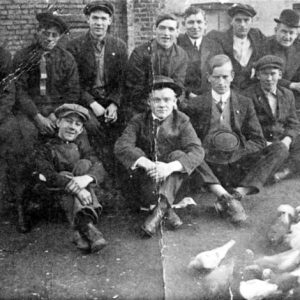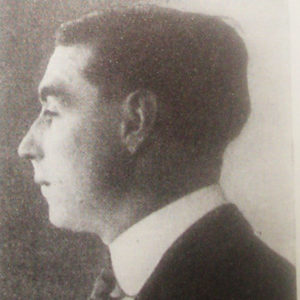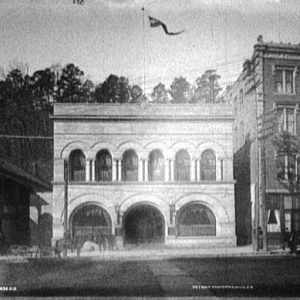calsfoundation@cals.org
Owen Vincent Madden (1891–1965)
Owen Vincent “Owney” Madden was a gangster and underworld boss in New York City in the 1920s who retired to Hot Springs (Garland County) in the 1930s. Though his role in Arkansas politics and history will forever remain enigmatic, he was a powerful figure (from about 1935 until his death) during the heyday of illegal gambling in Hot Springs and an emblem of the bad old days of machine politics.
Owney Madden was born on December 18, 1891, in Leeds, England, to Irish parents, Francis and Mary Madden. He spent his early childhood in Wigan and Liverpool, where Francis worked in textile mill sweatshops until his death in 1902. Mary then took her family, including Madden and perhaps two siblings, to New York. They settled in a crime-ridden Manhattan district along Tenth Avenue known as Hell’s Kitchen. She worked as a scrubwoman, while Madden sporadically attended St. Michael’s Parochial School on West 33rd Street.
According to his own account, Madden committed his first crime at age fourteen, clubbing a man and stealing $500. He rose to lead the area’s most violent gang, the Gophers. In 1911, Madden married and briefly lived with Dorothy Rogers, with whom he had a daughter named Margaret, his only known child. A professional killer and gunman, he was wounded many times. In 1915, he was sentenced to Sing-Sing Prison in Ossining, New York, for manslaughter, and he was paroled in early 1923. By then, the Eighteenth Amendment, which marked the beginning of the Prohibition Era, had made the manufacture, transportation, and sale of intoxicating liquor illegal. During Prohibition, numerous underground bars and saloons appeared, and the market for bootleg alcohol boomed.
Now in his element, Madden made fast profits in bootlegging, nightclubs, and show business. Among other enterprises, he turned a failing Harlem night spot at Lenox Avenue and 142nd Street into the Cotton Club, the fabled showcase for black musical talent performing for white patrons in the Jazz Age. Madden also bankrolled the Hollywood careers of George Raft and Mae West, both of whom had lived in Hell’s Kitchen. He was Mae West’s boyfriend and protector: “Sweet, but oh so vicious” was how she described him in later years.
By the late 1920s, Madden was a millionaire, chief of an underworld empire that included real estate, boxing, gambling, bootlegging, breweries, and entertainment. With Frank Costello, Charles “Lucky” Luciano, and other mob figures, he organized a “crime commission,” or syndicate, whose objective was high profits, a businesslike operating style, and a minimum of bad publicity.
By 1930, New York governor Franklin D. Roosevelt was seeking a presidential nomination; a crackdown on the blatant corruption of New York City was essential to his plan. On July 7, 1932, Madden was sent back to Sing-Sing for parole violations. In 1933, he was released, and Prohibition was repealed late that year.
In his forties and in chronic ill-health because of his old bullet wounds, Madden was persona non grata in the New York underworld. Looking for a new life, he began visiting Hot Springs, which had for years been a haven for gambling, prostitution, and bootlegging. The city was also a peaceful little spa, known for its beauty and its health-giving hot waters. Perhaps contemplating a settled life as an exiled but still active mobster, Madden began romancing a Hot Springs gift-shop clerk, Agnes Demby, the daughter of the local postmaster. On November 26, 1935, when she was thirty-four and he was in his mid-forties, they married and moved into a modest house on West Grand Avenue. Contrary to myth, Agnes was not a small-town ingénue but was well acquainted with her husband’s racketeer friends, his prison record, and his way of life.
Under what terms Madden left New York will never be known; high-placed New York politicians and criminals may have struck the deal, possibly with Frank Costello as broker or Lucky Luciano, who may have commissioned Madden to oversee mob operations in Hot Springs. Confined to Arkansas, Madden played a public role as a small-town gentleman, but it is reasonable to think that he played an active part in illegal activities in the spa. Hot Springs Mayor Leo P. McLaughlin and Municipal Judge Vern Ledgerwood ran their own syndicate to manage gambling and prostitution, and while they stoutly denied that Madden had any hand in things or took any rake-offs, it was common knowledge that Madden furnished the wire service that brought racing results to bookmakers. It seems unlikely that he and his mob associates provided this valuable service for free. Madden stayed underground until around 1940 but eventually came to own a controlling interest in the Southern Club, a lucrative gaming establishment on Central Avenue, as well as other gambling operations. A who’s who of gangland chiefs—Costello, Luciano, Meyer Lansky, and Joe Adonis—visited Madden regularly and openly.
In 1946, the McLaughlin machine was voted out, but local rackets, after a few setbacks, continued to flourish, and Madden grew more visible and more powerful. Under constant FBI surveillance, Madden continued as godfather to local charities and became a familiar figure in his trademark cap and scarf. In 1961, after a federal investigation concluded that Hot Springs was the site of the largest illegal gambling operation in the U.S., Madden was summoned before the Senate Committee on Organized Crime under Arkansas Senator John McClellan (“the rackets committee”), where he repeatedly invoked the Fifth Amendment.
In 1964, the state government took its first decisive steps to shut down illegal operations in Hot Springs. A year later, on April 24, 1965, Madden died of emphysema and was buried in Greenwood Cemetery.
For additional information:
McLane, Bobbie Jones. “Owen Vincent ‘Owney’ Madden: Hot Springs Resident Extraordinaire.” The Record 46 (2005): 19–28.
Nown, Graham. Arkansas Godfather: The Story of Owney Madden and How He Hijacked Middle America. Little Rock: Butler Center Books, 2013.
Shirley Tomkievicz
New York City, New York
This entry, originally published in Arkansas Biography: A Collection of Notable Lives, appears in the CALS Encyclopedia of Arkansas in an altered form. Arkansas Biography is available from the University of Arkansas Press.
 Early Twentieth Century, 1901 through 1940
Early Twentieth Century, 1901 through 1940 Law
Law Gopher Gang
Gopher Gang  Owen Madden
Owen Madden  Southern Club
Southern Club 




I knew Owney’s brother, Marty, as a small child because my parents lived on the farm “Somerset” owned by Marty, where he raised and trained thoroughbred race horses. I like him and his wife, Kitty O’Brien Madden. They were very kind to us. I am currently writing as much as I know and remember about the history of Marty and “Somerset” and will include farm-related pictures from the 1940 era. I have never seen any comments about Owney’s connections or involvement in activities in Cuba; at that time many gangsters were organizers and ensconced in activities that were legal in Cuba and not in the US. I have a letter from Marty written to my father, Oct. 7, 1953, where he says “they were looking to grab his brother, Owen, but I was the one who fell into the trap.” Marty took a trip to Cuba–my guess is at the direction of his brother Owen, perhaps for reconnaissance, and when Marty tried to return to the US, he was charged with failing to register in 1951, ’52, and ’53, under the McCarran Act. The US tried to deport him, and he asked my father to be a witness, to his character and reputation, if necessary. On August 12, 1955, Congress and the attorney general discontinued any deportation proceedings and canceled orders, warrants, and arrests against Martin Aloysius Madden. Marty was not a notorious gangster like his brother. However, he says that “they were the leaders of pretty tough boys and he had a criminal record by the time he was 20.” But “the last 30 years I led a real good clean life, never being arrested once.”